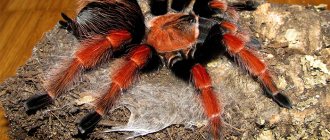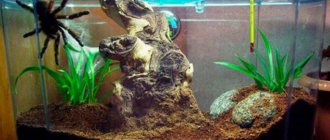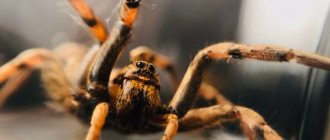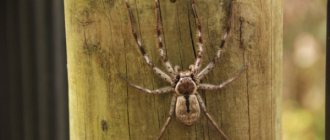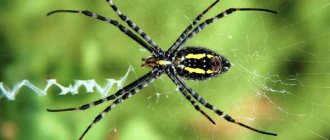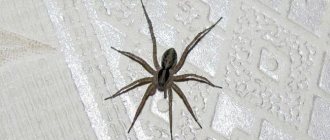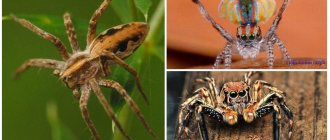Problem of choice
Not every member of the arthropod family can be accommodated in your home: some have an inconspicuous appearance, others are deadly poisonous and therefore pose a danger to people and animals.
The best spiders for the house are tarantula spiders. Large sizes, bright colors, shaggy bodies: tarantulas are distinguished by their excellent external appearance, which is why they attract the attention of lovers of exotic animals.
There are several species of tarantula spiders that you can keep at home. Each of them has its own characteristics.
Giant tarantula
Everyone decides for themselves, based on their taste and conditions, which spiders can be kept in their home, but most often the choice is the giant tarantula. It’s not called that for nothing: the leg span of an adult is at least 25 cm, and the body grows up to 10 cm in length. They are inactive, mostly sitting near their burrow.
Bicolor tarantula
The leg span of adult representatives of this species can be about 16-17 cm, and the body length can be 7-8 cm. Females can live up to 20-23 years, while males live 5 times less. The peculiarity of two-colored tarantulas is their calm nature.
The maintenance features are almost the same as for giant tarantulas, but there are some differences:
Mexican red-legged tarantula
The leg span of spiders can reach 14-16 cm, and the body size is about 7 cm. Red-legged Mexicans live for more than 25 years. Peculiarities:
Mexican red-legged spider
Other
There are several other types of tarantulas that are suitable for home keeping:
On a note! What type of spider to have at home is up to everyone to decide for themselves, but it is necessary to take into account not only its beautiful color and size, but also the characteristics of feeding, maintenance, and the level of danger.
Blue tarantula
One of the most striking representatives of tarantulas has a rich blue color. The span of his paws can reach 17 cm. His entire body is covered with fluffy hairs, which is why he seems cute and harmless. But that's not true. The bite of this spider is quite painful and can cause unpleasant consequences. Blue tarantulas live in the southwest of India, but you can also see them in the home collections of spider lovers.
Where are spiders kept?
The best place for spiders to live in a house is considered to be a terrarium made of plastic or glass. The container must be hermetically sealed, but at the same time have good ventilation.
On a note! To create ideal living conditions, it is extremely important to know the natural living conditions of the selected spider - how long the pet will live depends on this.
The size of the terrarium depends on the size of the pet itself. For a young spider that has only survived a few molts, you can use a plastic container measuring 6x8x10 cm as a house, and for an adult tarantula you need a terrarium measuring 30x30x30 cm. It is better not to use large containers - the pet will feel discomfort in them.
Only one individual can be kept in one container. The babies are kept together until the first moult, and then they also need to be seated, otherwise injury and death of the pets may not be avoided.
Before you move your pet in, you need to properly prepare its house:
Reproduction of spiders, features
The spider's reproductive organ is located in front of the spinning organ . After mating, the male is often extremely careful, since some species of females are capable of killing their sexual partner and using him for food.
This is interesting! Males of some common species after mating do not care at all about their safety and absolutely calmly allow the female to eat them, and some species are capable of living together for a long time.
A few weeks or months after mating, the female begins to make a special cocoon, which she can move around the terrarium in search of the most comfortable conditions. At a certain time, the female independently opens the cocoon and many tiny spiders are born.
Is it better to get a male or a female?
It all depends on the wishes of the owner himself. For those who want to watch the happy life of a pet for a long time, it is better to get a female. In this case, it will be cheaper to purchase a male spider.
House Spider: Pros and Cons
The advantages of keeping spiders in your home include the following:
Unfortunately, there are also disadvantages of keeping such pets:
Important! Any manipulations in the terrarium must be performed very carefully and only with the help of long tweezers.
House spider tarantula for beginners
As a rule, large spiders are found in the tropics, where the climate is constantly warm and humid. Some species prefer to live in the ground, where they build entire labyrinths, as well as in trees, constructing huge trapping nets. Often, the habitat of some species depends on age: at a young age they are found in the thickness of the earth, and as they grow older they move to trees or plants.
It is important to know! When keeping the tarantula spider at home, conditions should be created that are close to natural. To do this, before purchasing it, you need to study the features of the environment in which they prefer to live. If this is not done, the animal will quickly die from stress.
You should always remember that these spiders are poisonous, despite the fact that they have a peaceful nature and do not show aggression. For beginners, we can recommend the following types:
For professionals, the species “Lasiodora Parahybana”, “Grammostola”, “Acanthoscurria” are suitable. The Goliath tarantula is considered a real decoration of any collection, and is also one of the most beautiful spiders in the world. Reaches a length of about 28 centimeters.
Brazilian spider crab
A uniquely shaped body with numerous protrusions and the ability to adapt to its surroundings help these spiders hunt insects. Their belly color is usually white, sometimes with a pinkish or blue tint. Habitat: Latin American countries. The Brazilian spider crab is best at pretending to be a tropical flower, misleading its potential prey.
Choosing a pet
Since the role of a pet must certainly be a bright, eye-catching specimen, accordingly, the option with our practically “native” haymaker spider immediately fades into the background. And why disturb the cute eight-legged “neighbor” by driving him into a terrarium, besides, these creatures are already domestic and probably huddle in one (in most cases, several) of the cozy corners of your house. We’ll leave them there, and for home keeping we’ll choose someone nicer, for example, a tarantula. By the way, representatives of this particular species are the most common and popular spiders for home keeping. And there are several reasons for this:
However, tarantula spiders are far from the only representatives of their order that are chosen for home keeping. In addition to them, wolf spiders, often tarantulas, cross spiders and even baby jumping spiders are also in demand.
Criterias of choice
Having come to a pet store, say, for a kitten, we roughly understand what requirements to put forward for it: clean eyes, ears, a wet nose, etc. But what about the spider? What parameters should this creature advise?
So, let's examine the spider we like. It should be:
On a note! When a spider is disturbed by painful sensations, it scratches its abdomen with its hind legs, tearing off some of the fibers!
9.Latrodectus mactans (Black Widow)
The ninth place among the most beautiful spiders on the planet is occupied by Black Widows. They account for many human lives. A Black Widow bite most likely leads to death or serious health consequences if an antidote is not administered in time. This is despite its small size - a maximum of two centimeters in diameter. The spider got its name because the females of this species eat the males after mating. Their appearance is not distinguished by very bright colors; it can even be called modest. The abdomen is painted black with a matte sheen, and has small red spots on it. This simplicity looks quite beautiful.
Types of domestic tarantula spiders
White-haired tarantula
Adult body: 7 cm
Length of residence: Female - 12 years; male - 3 years.
Natural Lifestyle: The white-haired tarantula is one of the calm species, freely allowing itself to be handled. Avoid close contact only with hungry spiders to avoid being bitten. The spider inhabitant of tropical forests lives in a dug hole in the roots of trees.
Protection: Sticks out the chest and throws out hairs from the abdomen, which, if they get on the mucous membrane of the eyes or the surface of the skin, cause discomfort.
Keeping at home: Tarantulas should be kept in a glass or plastic container with a volume of at least 5 liters. The terrarium must be closed, as spiders move well on the glass surface.
Vermiculite, lichen, pine sawdust, and sphagnum moss are suitable as bedding. Pieces of bark or coconut shells should be added to the litter to create a burrow. The substrate is applied in a layer of at least 5 cm.
Each individual of this species should be kept separately ; hungry spiders are prone to cannibalism. For young individuals, feeding is carried out 2 times every 7 days, for adults once a week. The menu serves newborn mice or insects of suitable size.
Air temperature: from 23 °C to 28°.
Molting: The tarantula during or before molting can limit itself in food, sometimes to the point of complete refusal. The moult is going critically. The spider stops moving and lies on its back. The interval in an adult varies from 2 months to 1 year. In young people the process occurs
Giant tarantula
Body of an adult: 9−10 cm.
Leg span: 20−25 cm
Duration of residence: 12 years for females. Males are often eaten immediately after mating.
Features: Lives in the tropical forests of Brazil. Females are larger in size than males. The color is two-tone: reddish-brown or grayish-black. A sedentary individual, it often spends its time near the burrow.
Defense: Uses its hind paws to shake off the hairs located on the abdomen. Hair can cause an allergic reaction.
Temperature in the terrarium: 22 °C - 26°.
Humidity: 70—80%
Bicolor tarantula
Body of an adult: 7−8 cm.
Leg span: 15−16 cm
Duration of residence : Males - 4 years, females - more than 20 years.
Protection: Without hesitation, he uses hairs that cause itching when they come into contact with the body.
Maintenance at home: Standard sized terrarium with 5 cm of bedding. The coconut type is more suitable as a substrate. Feeding is done 1 or 2 times every 7 days. Large-sized feeding insects are served as food.
Temperature: 24°C-28°.
Humidity: 65—75%
Mexican red-legged tarantula
Body of an adult: 6−7 cm.
Leg span: 15−16 cm
Duration of residence : More than 25 years
Keeping at home: Inhabitant of semi-desert regions of Mexico. Spends most of its life near the burrow. The character is calm, can become a friend to a beginner in keeping. The substrate is poured from 5 cm and above; the individual is accustomed to digging holes. The Mexican red-legged tarantula will be happy with a built shelter and a cup of clean water in the terrarium. Common insects are used as food, once a week. Young individuals are given food 2-3 times every 7 days. The bite of this house spider can only be harmful to those who suffer from allergies to a bee or wasp sting.
Defense: Uses irritable hairs.
Temperature: 25°C-28°
Moisture: 60—70%
Striped tarantula
Body of an adult: 9−10 cm.
Duration of residence: Up to 15 years (females).
Suitable food:
Protection: Combs off allergenic hairs at every opportunity.
Temperature: 23°C-27°.
Humidity: 70—80%
Horned tarantula
Adult body: 6 cm
Length of residence: 15 years or more.
Housekeeping: This house spider is native to East Africa and has 1 horn on its cephalothorax. He leads an active lifestyle, especially at night. Beginners are not advised to own a horned tarantula, as a representative of this species is very aggressive in nature.
Temperature: 26°C-28°.
Blue tarantula
Adult body: 9 cm
Duration of residence: Females up to 20 years, males 4 years.
Temperature: from 25 °C to 27°.
Chrome tarantula
Adult body: 8 cm
Leg span: 15−19 cm
Duration of residence: up to 20 years
Keeping at home: Homeland - Eastern Brazil. Most of their life is spent in burrows under the roots of trees and shrubs. There are stinging hairs on the abdomen, but the spider uses them very rarely. The character is calm, sometimes nervous, active . A horizontal terrarium with dimensions of 40×40×30 cm is suitable.
Substrate - 5-10 cm, moss, peat, coconut. A drinking bowl is required in the terrarium. Food for adults once a week. Insects of suitable size are on the menu. They rarely bite, but the bite is toxic and caution should be exercised upon contact.
Conditions of detention: how to arrange a home
In order for an exotic pet to delight you with its presence for a long time, you need to work hard on the equipment of its home. When arranging a terrarium, it is necessary to think about lighting, decor and filling, and regulate the temperature and humidity of the air.
What is needed in a terrarium
The terrarium must have a layer of substrate. Firstly, this will help recreate a more natural environment for your pet, and he will not sit on bare plastic or glass. Secondly, the main task of the substrate is to maintain a stable level of humidity inside the container. For this reason, neither sand nor stones are suitable as a filler. The most acceptable options are vermiculite and coconut filler. Both fillers are highly hygroscopic.
The need for decoration is determined by the type of your pet. For example, for spiders that weave webs, no special decoration is required, since soon it will not be noticeable under a layer of beautiful lace. The main thing is to provide your pet with all the conditions for weaving. But for species that like to hide in shelters, you can buy ceramic houses, castles and shards, products made from cork oak or artificial plants.
In addition to the spider, you can also have a cat, dog, fish, parrot, hamster or guinea pig in your house.
Sealing and ventilation
It doesn’t matter what you use as a home - a food bowl or a special glass terrarium, it must be securely closed with a lid, otherwise one morning you may find that the spider’s house is empty, and its owner is walking around your apartment. But when sealing the container, do not forget that the arthropod needs fresh air and high-quality ventilation of the container, so several holes should be made in the lid through which the spider will not escape, but will gain access to oxygen. If your pet lives in a plastic container, it is better to make holes on the side wall in two rows: bottom and top. To do this, you can use a hot nail of small diameter.
Decorative elements for terrarium
When your spider becomes big enough to move into a large terrarium, be sure to take care of the decorative elements of its interior. Beautiful and large stones, an empty coconut shell, a fragment of a clay flower pot, bamboo stems, dry branches and even a model of a skull - all this will decorate the landscape of the terrarium and serve as a refuge for the spider. Just make sure that the decorative elements of the terrarium do not injure your pet, therefore, they should not have sharp corners or cutting ends.
You can also plant a real botanical garden in the spider’s house by planting aloe and gasteria there.
Depending on what kind of tarantula you have - there are ground and tree spiders that need a vertical type of terrarium, make sure to provide your little ones with the accessories they need.
Lighting
The need for decoration depends on the type of spider. For example, for tarantulas there is no need to install additional light, since they are nocturnal inhabitants who are excellent at navigating in the dark. If you want to install light, give preference to infrared lamps - their radiation is invisible to your pet. It is not advisable to choose incandescent lamps, but if you choose this option, install them outside the container to prevent the animal from being burned and the air from drying out.
Temperature
Spiders are able to tolerate a very wide temperature range. Optimal values are 23-26°C. Additional heating may be needed only during the transitional autumn-spring period, when the heating is already turned off or is not yet working. To provide heat, you can purchase special cords and heating plates, as well as a thermostat. The devices must be installed either under a container (for tree spiders) or on the walls of the house (for terrestrial species).
Important! The temperature in the room and terrarium should not exceed 31°C.
Humidity
This indicator is very important for the health and well-being of the pet. The required humidity level for each species may vary. You can determine a deficiency or excess of moisture by your pet’s behavior:
You should not spray the substrate with a spray bottle; instead, it is better to use a syringe without a needle or a watering can with a thin hole. It is important to determine by eye when there is enough moisture (the substrate should be 2/3 wet). Adults must have a drinking bowl in the container; choose its size in such a way that the pet cannot fit into it and drown. Keep in mind that swamp cultivation should not be allowed in the terrarium. In conditions of excessive humidity, midges, mold and fungus easily grow, which can kill the arthropod.
How to feed a tarantula spider
As for the spider's nutrition, it has its own characteristics. It must be fed with live food. You can feed young individuals once every two or even three days, and adult tarantula spiders once every two weeks.
The food should not exceed the size of the spider, otherwise it will be difficult for it to digest the prey. The basis of the tarantula's diet in apartment conditions is mealworms, crickets, marbled cockroaches, and zoophobes.
The food supply can also be bred at home, in plastic containers. Or buy from more experienced breeders who breed food for their animals. It is also necessary to ensure that tarantula spiders and pets always have constant access to clean water. It is not difficult to find a drinking bowl in a pet store or, if desired, to make it yourself from available materials.
In conclusion, it is worth emphasizing that absolutely all spiders are poisonous. Therefore, when communicating with a tarantula spider, even the calmest one, it is not recommended to pick it up. By the way, when cleaning the terrarium and feeding, use long tweezers.
The poison does not pose a mortal danger to humans. But the poisonous hairs with which the spider is covered can cause unpredictable allergic reactions if it comes into contact with the skin. In addition, the spider may be stressed! For example, finding yourself in an unusual environment outside the terrarium, with conditions created suitable for it.
The maintenance of different species of tarantulas can vary significantly depending on the specific species, but is generally similar. The decision on which of the many commercially available tarantulas to place in your home is, of course, made by the future owner, based on personal preferences.
Karakurt
These representatives of the black widow genus are considered one of the most poisonous spiders on the planet. They can be recognized by 13 red spots on their jet-black body. But this is not so easy to do, because the size of the spider does not exceed 3 cm. These fatal beauties live on all warm continents, so the likelihood of meeting them is quite high. This spectacular lady may not evoke the most pleasant emotions, but you cannot deny her a stylish appearance.
What to feed house spiders
Despite the fact that your house spiders are completely domesticated creatures, they are predators, and accordingly they feed on living organisms. Small spiders eat cockroaches and crickets, but large ones can eat mice and frogs. You can also try giving a piece of lean meat or squid fillet. However, the latter types of food are not very natural for the spider, therefore, from such a diet they may begin to get sick in the future. So, it is best to feed spiders what they eat in nature.
As for the size of the portions, they should be 1/3 of the volume of the spider itself.
How often should you feed spiders?
The frequency of feeding spiders depends on their age. So, if you have a young house spider, you need to feed it several times a week. Whereas an adult spider can be fed several times a month. By the way, there are often cases when adult spiders can go on hunger strikes - you shouldn’t be afraid of this - the spider either overate the day before, or is preparing to molt, or the air temperature in your terrarium is low and it is preparing for hibernation.
What to do if a spider refuses food
What should you do if you find yourself in a situation where your pet refuses both a cricket and a mouse? In this case, first, you need to remove its “lunch” from the terrarium in order to prevent a situation where the spider becomes a victim of its lunch, and only then start to find out the reasons for this situation
Argiope lobata
The spider, which in appearance resembles a squash, lives in the desert and steppe regions of southwestern Eurasia and North Africa. The size of the spider is only 1.5 cm. Its distinctive feature is the unusual structure of the abdomen with small uniform protrusions along the entire perimeter. The color of the argiope is very similar to a shell. The top of the body is covered with silvery hairs, which makes it shiny and helps to lure prey into the web. The bite of a squash spider is not dangerous for humans, but grasshoppers and other insects cannot escape its webs alive.
How spiders molt
One of the most important periods in the life of a house spider is the period of its molting, during which time the old exoskeleton is replaced with a new one. Thus, small spiders molt once every 20-30 days, while with large spiders this happens once every few months. And here are adult female spiders - they can molt once every few years. By the way, the age of tarantula spiders is usually measured by the periods of molting they experience. So, remember this.
How to tell if a spider has started molting
As a rule, before the onset of the molting period, your spider will begin to refuse food, become inactive, and if it has a bald spot on its abdomen, it will darken, and before the start of the molting itself it will turn black. The color of the spider will become dull, and your pet will look not like a well-groomed house spider, but like some kind of goner. You shouldn’t be afraid of this - these are natural processes. Also, the spider begins to build a hammock - a web - on the ground, but if you have a tree spider, it will choose a higher place for such a construction. After this, the spider climbs into such a hammock and lies down on its back. It can lie in this state for several days. And then... a real miracle happens. The old skin in the back area begins to crack and a completely new spider crawls out of it. It is absolutely forbidden to help him during this procedure. You can simply damage the spider itself and the insect will die. If you really want to help, adjust the humidity level, then the spider will have all its legs intact, and it will be active and cheerful.
After the new spider has emerged from the body of the old one, it lies on the old skin for some time and rests; in this state, its skin is still soft and easy to injure - so you shouldn’t poke the new spider with tweezers or touch it with a brush. . After a new incarnation into the world, the spider can remain in this state from several days to several weeks. It's different for every spider. Then, it will activate and become mobile again, and you will notice that not only its color has become bright, full and more saturated, but the spider itself has grown.
When its skin hardens, the spider itself will get rid of the old skin (throw it into the corner of the terrarium). Now you can try to feed it, however, be careful - the spider after molting is very mobile and active. So make sure he doesn't escape.
Injuries during molting
If something goes wrong, and after molting the spider is left without one or more legs, do not despair, if it is young, after a few molts the leg will be restored. But, if you have an adult male, most likely he will die. Read more about spider molting here.
Eight point crab spider
This unusual, like a toy, spider lives in Indonesia, on the islands of Sumatra and Java. The length of its body can reach 4 cm. It needs its bright yellow or orange coloring for camouflage during hunting. He is capable of sitting motionless on a flower for several hours in a row, waiting for a bee and another unlucky insect, which, due to the deceptive appearance of the spider, does not see it as a threat.
Answers to popular questions
Keeping spiders at home is accompanied by various emergency situations that require immediate resolution. Let's look at a few typical problems and methods for eliminating them:
Is it possible to pick up spiders? A spider cannot be called a full-fledged tame animal. Therefore, any attempts to tame or “train” a pet are initially doomed to failure. Many people wonder whether it is possible to pick up a pet. The answer is ambiguous because predicting the likelihood of a spider's behavior is difficult. A change in temperature, humidity level or amount of light can negatively affect arthropods. The result of such taming can be different: the spider will run away, bite, get scared, or even die soon.
What to do if you are bitten by spiders? Often, house spider bites do not pose a danger to humans. The exception is people with a tendency to develop an allergic reaction. In case of acute attacks of allergies and the lack of timely medical care, anaphylactic shock and even death are possible.
Typically, a house spider bite is accompanied by a slight burning sensation, itching, redness or swelling at the site of the lesion. To protect yourself from negative consequences, you need to apply a tourniquet above the bite site. The wound should be washed with water and soap and treated with any antiseptic. It is advisable to take an antihistamine. Don’t forget to drink plenty of fluids to prevent intoxication of the body.
What to do if a spider “escapes” from the terrarium? Most often, the spider leaves its home when the seal of the terrarium is broken. Also, a pet’s “escape” is possible in a stressful situation, after molting or a feeding disorder. First, it is necessary to determine the current location of the “fugitive”, only then - to carry out measures to return him to the terrarium. So, having found a spider in the room, cover the “fugitive” with a wide container. Now carefully slide a sheet of thick cardboard under the arthropod. Lift and carefully carry the structure, move the spider into the terrarium, and close the container tightly.
How long do house spiders live? The lifespan of a spider depends on compliance with housing conditions, proper care and feeding. This factor is also influenced by the species characteristics of the animal. For example, tarantulas, popular among spider breeders, can live 15-20 years, goliaths - 6-9 years, peacock spiders - about 9-10 months. Tarantulas, which are also actively bred at home, live in captivity from 1 year to 30 years. Life expectancy depends on the breed. In addition, females live significantly longer than males.
Danger to humans
Before you get such an undemanding pet at home, you should find out how poisonous it is. It must be remembered that although this type of spider can bite a person, these bites do not pose a danger.
The bite site becomes inflamed, followed by swelling and swelling. All this is accompanied by pain. After about a week, the negative consequences of the bite disappear. This is especially true for people prone to allergies, as well as those with weakened immune systems. After a bite, such people experience a deterioration in their general health and severe weakness, with nausea, diarrhea, dizziness and headache.
Spiders cannot be trained in any way, so a person must study their behavior patterns. If the spider has poisonous hair, then it is better to handle it while wearing gloves, otherwise it may irritate the skin.
It is important to know! There is a category of people suffering from arachnophobia - fear of spiders. If such a person accidentally and unexpectedly encounters a tarantula spider, he may die of fear. In this regard, it is necessary to ensure that the animal is not able to leave the terrarium and does not start traveling around a person’s home, or even worse, among its neighbors.
How much does a tarantula spider cost?
These exotic animals are not that cheap, as some of the species cost a lot of money. You can purchase a tarantula spider in various ways: via the Internet or through an advertisement, or by going to a pet store. Depending on the type, you will have to pay from 100 to 10 thousand rubles. Moreover, females are always more expensive.
When choosing a pet for yourself, you should pay attention to a number of factors, including age. It is better not to buy too large individuals, as they may be old. Secondly, you should pay attention to the shell. If they are damaged or have wrinkles or cracks, it is better not to take such individuals, as they may turn out to be sick. It is not recommended to buy spiders before or immediately after molting, since it is not possible to determine how active the animal is.
Source
